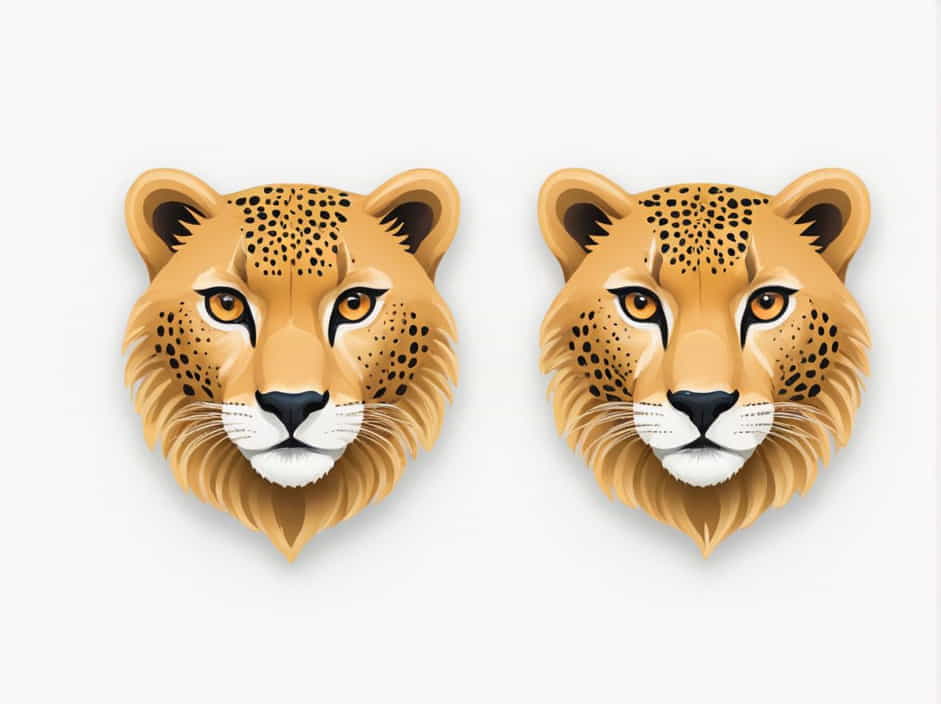Cheetahs and leopards are two of the most famous big cats in the wild, but many people struggle to tell them apart. While they may look similar at first glance, these two species have distinct differences in appearance, behavior, habitat, and hunting techniques.
This topic will explore the major differences between cheetahs and leopards, helping you recognize each species and understand their unique characteristics.
Physical Differences: How to Identify Cheetahs and Leopards
1. Body Shape and Size
One of the easiest ways to distinguish a cheetah from a leopard is by looking at their body shape.
- Cheetahs are slender and built for speed, with long legs, a lightweight frame, and an aerodynamic body. They can weigh 35-60 kg (77-132 lbs) and reach a height of 70-90 cm (28-35 inches) at the shoulder.
- Leopards have a stockier, more muscular build, with powerful limbs designed for strength and stealth. They weigh 50-90 kg (110-200 lbs) and stand at 60-70 cm (24-28 inches) at the shoulder.
2. Coat Pattern and Spots
The patterns on their fur provide another clear distinction.
- Cheetahs have solid black spots evenly distributed across their golden-yellow coat. These spots are small, round, and do not form clusters.
- Leopards have rosette-shaped spots—black markings that form circular patterns with a lighter center, giving their fur a more complex and textured look.
3. Facial Markings
A cheetah’s black “tear marks” running from the inner corners of its eyes down to its mouth are one of its most recognizable features. These marks help reduce glare from the sun and improve focus while hunting.
Leopards do not have tear marks but instead have small, irregular spots on their face that blend with their overall fur pattern.
4. Tail Shape and Length
Cheetahs have long, flat tails with distinctive black rings at the tip. Their tails act as a rudder to help them maintain balance while running at high speeds.
Leopards have shorter, thicker tails that help them climb trees and maneuver through dense vegetation.
Speed and Hunting Abilities
1. Speed and Endurance
Cheetahs are the fastest land animals, capable of reaching speeds up to 112 km/h (70 mph) in short bursts. Their lightweight bodies, long legs, and flexible spines allow them to accelerate rapidly when chasing prey. However, they lack endurance and can only maintain top speed for about 20-30 seconds before exhaustion sets in.
Leopards, on the other hand, are not built for speed but for strength and stealth. They can run up to 58 km/h (36 mph) but prefer ambush hunting rather than high-speed chases.
2. Hunting Techniques
Cheetahs hunt during the day (diurnal predators) and rely on their keen eyesight and incredible speed to chase down antelopes, gazelles, and small mammals. They trip their prey with their front legs before delivering a suffocating bite to the neck.
Leopards are ambush hunters and primarily hunt at night (nocturnal predators). They use their camouflage and powerful muscles to stalk prey silently before launching a sudden attack. Unlike cheetahs, leopards can drag their kills up trees to avoid scavengers.
Habitat and Geographic Range
1. Where Do Cheetahs Live?
Cheetahs prefer open grasslands, savannas, and deserts, where they have space to sprint after prey. They are found in sub-Saharan Africa, with small populations in Iran.
2. Where Do Leopards Live?
Leopards are more adaptable and can survive in a variety of environments, including forests, mountains, savannas, and even urban areas. They are found across Africa, the Middle East, and Asia, with populations stretching from South Africa to China.
Behavior and Social Structure
1. Are They Solitary or Social?
Cheetahs are more social than leopards. Males often form small groups (called coalitions) with their brothers, while females live alone with their cubs.
Leopards are solitary animals and only come together during mating season. They are highly territorial and will defend their area from other leopards.
2. Interaction with Other Predators
Cheetahs are not dominant predators and often lose their kills to stronger animals like lions, hyenas, and leopards. Because of this, they eat quickly after a hunt to avoid losing their food.
Leopards, being stronger and more aggressive, are better at defending their kills. They often drag prey up trees to keep it safe from lions and hyenas.
Reproduction and Lifespan
1. Cubs and Parenting
Both cheetahs and leopards give birth to small litters (2-4 cubs per litter). However, their parenting styles differ:
- Cheetah mothers raise their cubs alone for about 18 months, teaching them to hunt before they become independent.
- Leopard mothers are more protective and keep their cubs hidden for longer periods, as leopards face more threats from other predators.
2. Lifespan
- Cheetahs live 10-12 years in the wild and up to 17 years in captivity.
- Leopards live 12-15 years in the wild and up to 23 years in captivity.
Leopards tend to live longer because they face fewer natural threats compared to cheetahs.
Conservation Status
1. Are Cheetahs Endangered?
Yes, cheetahs are classified as Vulnerable by the IUCN. Their population is estimated to be around 7,000 individuals, with habitat loss, poaching, and human-wildlife conflict being major threats.
2. Are Leopards Endangered?
The conservation status of leopards varies by region. Some subspecies, like the Amur leopard, are critically endangered, while others are listed as Vulnerable. Their adaptability helps them survive, but they still face poaching and habitat destruction.
Although cheetahs and leopards may look similar, they are very different in terms of appearance, behavior, and hunting strategies. Cheetahs are slim, built for speed, and hunt in open areas, while leopards are strong, stealthy ambush predators that thrive in a variety of environments.
Recognizing these differences not only helps in identifying them but also highlights the importance of protecting these magnificent big cats for future generations.
